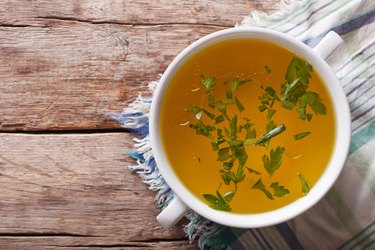
Plain old water is the most versatile cooking liquid there is. Unfortunately, when it comes to flavor, water doesn't bring a lot to the table. Broth and stock are two common replacements that can help you up your culinary game. They're both flavorful alternatives, but even in the case of their vegetable versions, they aren't exactly the same thing.
No Meat, No Bones
Video of the Day
With other kinds of stock and broth, it's usually the ingredients that decide which is which. A chicken or beef stock or any animal-based stock is mostly made with bones. You'll definitely add some aromatic vegetables like onions or carrots, and you may even use some meat, but most of the flavor and body comes from bones.
Video of the Day
With a broth, you'll still have the aromatic vegetables, but most of the flavor and body comes from meat. Obviously, that distinction doesn't apply to vegetable broth or stock, but there's another crucial difference that is important.
The Difference Between Vegetable Stock and Broth
The other crucial distinction between broth and stock is how they're intended to be used. Stock is always an ingredient that's used as a building block for other dishes, so it has minimal seasoning. All you should taste is the clean, delicate flavors of the main ingredients, ready to act as a backdrop or complement for other ingredients. You might use it as the base for a soup or a sauce, for example, but you aren't meant to drink it on its own.
A broth, on the other hand, is intended to be a finished product in its own right. It's fully seasoned, and you can enjoy sipping it straight from a cup if that's what you want to do. The whole question of veggie stock vs. broth, then, comes down to how you've flavored and seasoned it.
Two Kinds of Basic Stock
Whether you're making a regular stock or a vegetable stock, your first decision is whether you want a clear stock with delicate flavors or a dark stock with richer flavors. If you want a light, clear stock, you'll use fresh, raw vegetables and avoid ingredients like tomato paste.
If you want a darker, bolder stock, you'd start by roasting your vegetables first to caramelize them and deepen their flavors. Both kinds are good; it just comes down to what kind of dishes you want to make with them. Ideally, you'd have both in your freezer.
Best Stock-Making Vegetables
For a really good stock, you need a variety of sweet and aromatic vegetables. The usual ones to start with are onions, celery and carrots, which give a nicely balanced flavor. From there you can add shallots or leeks, bell peppers, mushrooms and – sparingly – herbs such as parsley, fennel, thyme and bay leaf. Things you'd otherwise waste, like the tops of carrots, the stems of your kale and pods from fresh peas, go great in most stocks.
Tomatoes add a lot of flavor as well, though they can overpower a light stock. A roasted stock will stand up to the tomatoes with a bit more panache, and you can even use tomato paste for a really bold-flavored stock. Avoid using potatoes or sweet potatoes and other starchy vegetables. Cabbage, turnips, broccoli and similar vegetables become bitter when they're simmered, so you should avoid those too.
Making Your Stock
If you're making a dark stock, start by misting your vegetables lightly with oil and roasting them until they're nicely caramelized. If you plan to use tomato paste, you can add that to the pan too, and it will develop a richer, milder flavor. If you're making a clear stock, you can gently "sweat" your onions and celery in the pot first with a bit of oil at low heat, which is optional but gives them a nice flavor.
Add about a quart of water for every pound of vegetables, and bring your pot to a gentle simmer. Let the vegetables go for as long as two to three hours if they're cut into big pieces of an inch or more or as little as 45 minutes if they're in quarter-inch dice. When the stock tastes distinctly of vegetables, and the vegetables taste like almost nothing, you're done. Strain the stock, and then cool and portion it for the freezer.
Turning Stock Into Broth
If you want to make broth instead of stock, follow the same steps but season it as it cooks with salt, pepper, garlic or any other flavorings you like. Taste it frequently so you'll know when it's right. Adding a piece of the rind from parmesan cheese adds lots of flavor. If you're making a vegan broth, you can get the same kind of boost from savory seaweeds like kombu or a small spoonful of miso. You can also turn stock into broth by just reheating it with these added ingredients.
Vegetable Broth vs. Soup
You can drink a finished broth just as it is, and it's a pleasant beverage, but it's not a satisfying meal. To turn your broth into a soup, the last step is to add some solid ingredients. These might include diced fresh vegetables, delicate baby peas, chopped fresh herbs or even a crouton of toasted bread.
Pasta and grains are excellent add-ins as well, though if you want to keep your broth clear, they should be cooked separately and rinsed first. For a real gourmet twist, try stirring in a small spoonful of flavorful pesto right at the table.